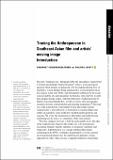Tracing the Anthropocene in Southeast Asian film and artists' moving image : introduction
Abstract
The idea of the Anthropocene brings to film studies (or, to be more precise, ecocinema studies) a specific emphasis on the planet’s spatiality and temporality. If globalization as a concept redefined film studies scholarship in the 1990s, resulting in the popularity of world, national and transnational frameworks, the Anthropocene presents a strong argument for today’s film scholars to urgently rethink the relationship between cinema, nation and the Earth in the face of environmental crisis. Forcing us to perceive time on a geological scale, the Anthropocene challenges us to correlate the histories of humans, nonhumans, cinema and the Earth. If we accept that the new geological epoch could be said to have begun in the 18th century, we might ask whether film studies itself can be seen as the study of the moving-image culture of this new epoch. This dossier responds to the urgent need to centre Southeast Asian film and artists’ moving image within these debates.
Citation
Chulphongsathorn , G & Lovatt , P 2022 , ' Tracing the Anthropocene in Southeast Asian film and artists' moving image : introduction ' , Screen , vol. 62 , no. 4 , pp. 533-540 . https://doi.org/10.1093/screen/hjab057
Publication
Screen
Status
Peer reviewed
ISSN
0036-9543Type
Journal item
Collections
Items in the St Andrews Research Repository are protected by copyright, with all rights reserved, unless otherwise indicated.

